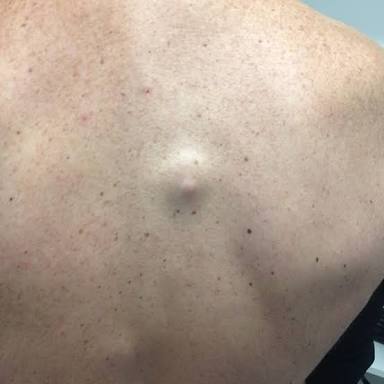Cysts
A cyst is a broad term for a fluid or semi-fluid filled sac that occurs within skin tissue and can appear anywhere on the body. Some cysts are microscopic, while others, if left untreated, can grow so large that they interfere with the function of internal organs.
Cysts develop a wall, unlike an abscess, which is also filled with fluid, but does not have a wall surrounding it. There are hundreds of types of cysts, many earning their name because of their location. These include ovarian cysts, pancreatic cysts, and pericardial cysts.
Although most cysts are benign and respond favorably to treatment, some cysts may be tumors and could be malignant. Among the malignant cyst candidates are keratocysts and dermoid cysts. Keratocysts occur in the back of the jaw. Dermoid cysts are slow-growing cysts that are often composed of skin, hair follicles, sebum, fat, blood and other body materials. In the rare cases that a dermoid cyst becomes malignant, it usually develops into squamous cell carcinoma in adults.
What are the symptoms?
Symptoms of cysts include finding an abnormal lump on the surface or just below the skin. They are closed pockets of tissue that can be filled with fluid, pus or other material. Skin cysts are usually slow-growing, painless and smooth to the touch when they are rolled under the skin. Cysts can appear anywhere, but generally appear on the face, neck, trunk and genital area. Cysts can also develop in the body at or near internal organs. In these cases, benign cysts can be undetected but are not problematic until they interfere with a body function. A lump that may be a cyst should be examined by a dermatologist.
Who gets it?
Anyone of any race or either gender may develop a cyst at any time; however, there are certain factors that make some people more susceptible than others. These include:
Post puberty
Male
History of acne
Significant sun exposure
Previous skin injuries
Treatment Options
Cysts can be effectively removed but the treatment protocol for removal depends largely on the location and cause of the cyst. Typically, visible cysts are treated through drainage or surgical removal.
Drainage – In most cases, fluid of the cyst can be drained by inserting needles into the cyst cavity, resulting in collapse of the cyst.
Surgery – If there is a suspicion of cancer, the cyst is generally removed by surgery or a biopsy is performed to rule out malignancy. Cysts that are very large and result in symptoms due to their size may also be candidates for surgical removal.
When a cyst is not visible, that is, when it is organ-centered or located elsewhere deep in the body, the options for treatment include:
Watch and wait – This process involves routine medical imaging of the cyst(s) to monitor their growth.
Biopsy – If there is a suspicion that the cyst is cancerous, a biopsy may be in order, depending on the location of the cyst.




Comments
Post a Comment